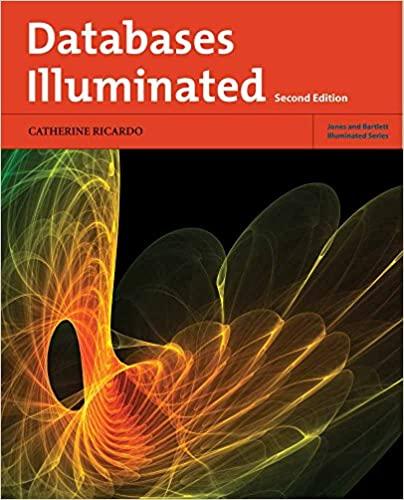Question
Need help with LaTex code. I am going to copy and paste it because it will not let me attach the tex so can someone
Need help with LaTex code. I am going to copy and paste it because it will not let me attach the tex so can someone help. Just recopy it without the errors as an answer or attack compilable copy! Thank you so much.
\documentclass[12pt]{article} \usepackage{amsmath, amssymb}
\begin{document}
\thispagestyle{empty}
{\bf \centerline{Writing Assignment 1}}
\vskip 0.5cm
{\bf 1.} For any set A, B, and C, prove that: \vskip 0.5cm
$(A\cap (B\cup C)=(A\cap B) \cup (A\cap C)$ \vskip 0.5cm
a) Prove: $(A\cap(B\cap C)\subset(A\cap B)\cup C)$
$(\forall x\in A\cap(B\cap C) so x\in A and x\in (B\cup C))$ \vskip 0.5cm
x is always belongs to set A and x is also a set to B or C. \vskip 0.5cm
$(x\in A and (x\in B)\bigvee (x\in C))$
Case 1: $(x\in B)$ \vskip 0.5cm
x is always belongs in A and in this case in B. So therefore, it is also in either A and B or the set is in C. Since x is in B in case one, it does not need to be in . \vskip 0.5cm
$(x\in(A\cap B)\cup C)$ \vskip 0.5cm
Case 2: $(x\in C)$ \vskip 0.5cm
$(x\in C)$ in case two, so the statement still holds true. \vskip 0.5cm
$(x\in(A\cap B)\cup C)$ \vskip 0.5cm
Therefore, $(A\cap(B\cup C)\subset (A\cap B)\cup C)$ \vskip 0.5cm
b) Prove: $((A\cap B)\cup(A\cap C)\subset A\cap (B\cup C))$ \vskip 0.5cm
$(\forall x\in(A\cap B)\cup(A\cap C) so x\in A and x\in (A\cap B)\bigvee(A\cap C))$ \vskip 0.5cm
case 1: $(x\in B)$ \vskip 0.5cm
since x always belongs to A, then $(A\cap(B\cup C))$ is true because it is in B and only needs to belong to B or C to be true. \vskip 0.5cm
$(x\in A\cap(B\cup C))$ \vskip 0.5cm
case 2: $(x\in C)$ \vskip 0.5cm
x always belongs to A so $(x\in A\cap(B\cupC))$ is true because x only needs to also belong in B and C and in case two, it belongs in C. \vskip 0.5cm
Therefore, $((A\cap B)\cup(A\cap C)\subset A\cap(B\cup C))$ and $(A\cap(B\cup C)\subset (A\cap B)\cup(A\cap C))$ so it follows $(A\cap(B\cup C)=(A\cap B)\cup(A\cap C))$ \vskip 0.5cm
{\bf 2.} using principle of mathematical induction, prove: $(1\cdot 1!+2\cdot 2!+3\cdot 3!+ \dots + n\cdot n!=(n+1)!-1$$ for all $n \in \mathbb{N})$ \vskip 0.5cm
a) base of induction: P(1)-T \vskip 0.5cm
Let $(n=1)$ $(1\cdot 1! = (1+1)!-1)$ $(1\cdot 1! = 1$ and $(1+1)!-1=1)$ $(1=1)$ so P(1) is True \vskip 0.5cm
b) Induction Step: $(P(n)\Longrightarrow P(n+1))$ \vskip 0.5cm
Assume: P(m) = $(1\cdot 1! + 2\cdot 2! + \dots + m\cdots m! = (m+1)!-1)$ \vskip 0.5cm
Want: $((m+1)!-1+(m+1)\cdot (m+1)!=(m+2)!-1)$ \vskip 0.5cm
$(1\cdot 1! + 2\cdot 2!+\dots+m\cdot m!+ (m+1)\cdot (m+1)! = (m+1)!-1+(m+1)\cdot (m+1)!)$ \vskip 0.5cm
$(=(m+1)!\cdot (1+m+1)-1)$ $(=(m+1)!\cdot (m+2)-1)$ $((m+2)!-1)$
\vskip 0.5cm
a) base of induction: P(1)-T \vskip 0.5cm
Let $(n=1)$ $(1\cdot 1! = (1+1)!-1)$ $(1\cdot 1! = 1$ and $(1+1)!-1=1)$ $(1=1)$ so P(1) is True \vskip 0.5cm
b) Induction Step: $(P(n)\Longrightarrow P(n+1))$ \vskip 0.5cm
Assume: P(m) = $(1\cdot 1! + 2\cdot 2! + \dots + m\cdots m! = (m+1)!-1)$ \vskip 0.5cm
Want: $((m+1)!-1+(m+1)\cdot (m+1)!=(m+2)!-1)$ \vskip 0.5cm
$(1\cdot 1! + 2\cdot 2!+\dots+m\cdot m!+ (m+1)\cdot (m+1)! = (m+1)!-1+(m+1)\cdot (m+1)!)$ \vskip 0.5cm
$(=(m+1)!\cdot (1+m+1)-1)$ $(=(m+1)!\cdot (m+2)-1)$ $((m+2)!-1)$
\end{document}
Step by Step Solution
There are 3 Steps involved in it
Step: 1

Get Instant Access to Expert-Tailored Solutions
See step-by-step solutions with expert insights and AI powered tools for academic success
Step: 2

Step: 3

Ace Your Homework with AI
Get the answers you need in no time with our AI-driven, step-by-step assistance
Get Started


